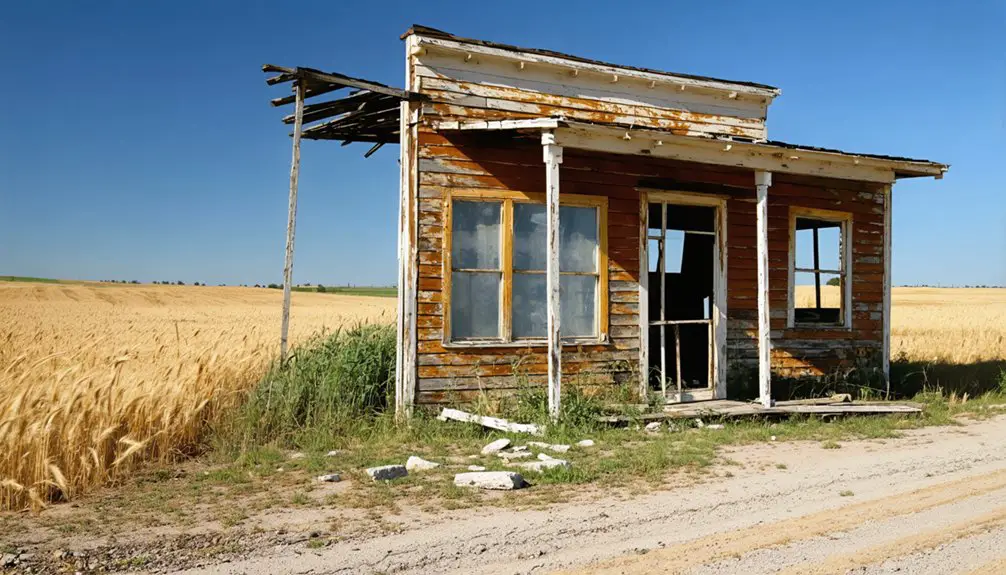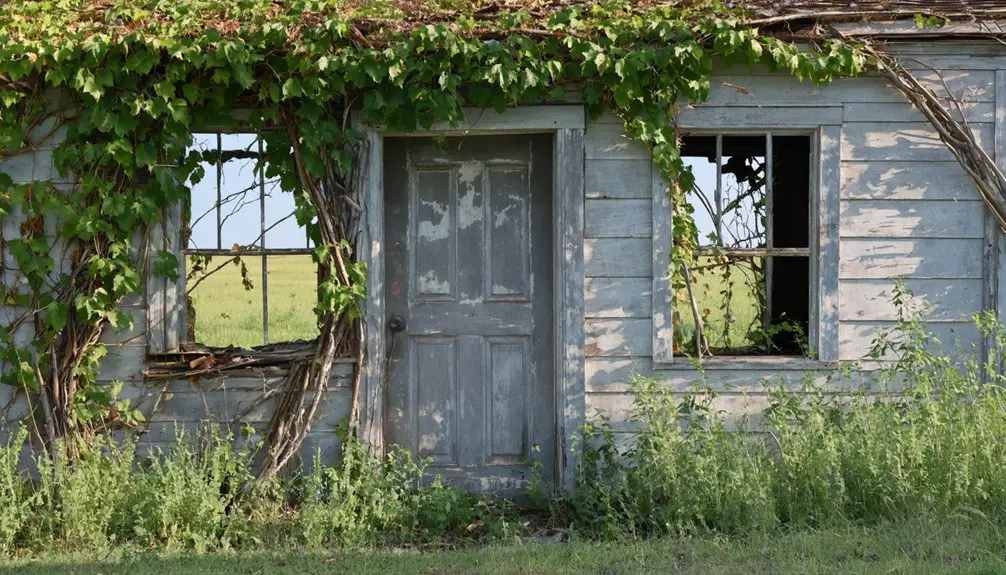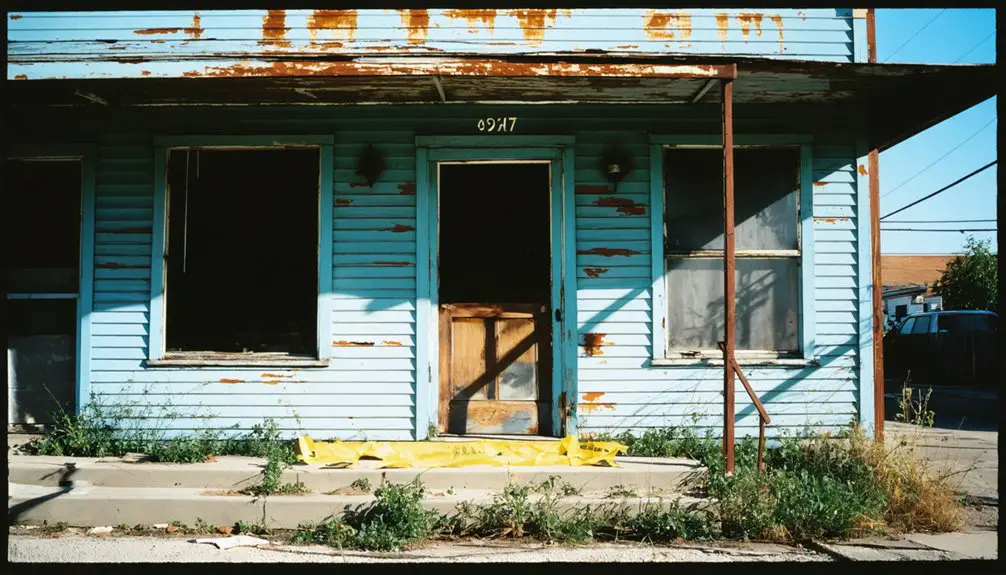You’ll find Beck nestled along historic Route 66 in Oklahoma, where it emerged as a railway stop in 1926. The town flourished with gas stations, motels, and diners serving cross-country travelers until the Turner Turnpike’s construction in 1953 began diverting traffic. While Interstate 40’s completion in the 1960s sealed its fate, Beck’s abandoned brick structures and stone buildings stand as remarkable examples of early 20th-century frontier architecture. Its stories of bootleggers and pioneering spirit await your discovery.
Key Takeaways
- Beck originated in 1926 as a railroad stop and flourished during Route 66’s heyday with gas stations, motels, and diners.
- The town’s decline began in 1953 with the Turner Turnpike construction, followed by the Interstate 40 bypass in the 1960s.
- Historic structures include a stone bank building and Chief theater, now deteriorating without preservation efforts.
- Natural reclamation has overtaken abandoned buildings, creating wildlife habitats among the old foundations and structures.
- Transportation limitations, including lack of direct railroad access and poor road connections, contributed to Beck’s eventual abandonment.
The Rise and Fall Along Route 66
When Route 66 carved its way through Oklahoma in 1926, the small town of Beck found itself positioned along what would become America’s most iconic highway. Like many towns along the Missouri, Kansas and Texas Railroad, Beck was already established as a rail stop before the highway arrived.
You would’ve seen the route evolution transform Beck into a bustling waypoint, where gas stations, motels, and diners sprang up to serve the steady stream of travelers heading west. Portland cement paving during the early 1930s brought improved road conditions and increased traffic through the town. The town’s community resilience shone through as it adapted to serve both locals and cross-country motorists.
But by the 1950s, Beck’s fortune changed dramatically. The Turner Turnpike in 1953, followed by the Will Rogers Turnpike in 1957, diverted traffic away from the town.
You’ll find that these new interstates spelled doom for Beck’s highway-dependent businesses, and when Route 66 was officially decommissioned in 1985, the town’s decline was complete.
Life in Early Beck Settlement
At Beck’s peak, you’d find settlers engaged in daily routines centered around farming, ranching, and trading essential goods at the town’s modest general store.
Your typical day might include bartering farm products with neighbors or participating in communal crop harvesting, while the railroad stop brought intermittent bursts of commerce as traders and travelers passed through.
Before major tourism development, the area relied heavily on subsistence farming as the primary means of survival.
If you were a local resident in those early days, you’d have witnessed how the railroad platform became a bustling hub where farmers gathered to ship cattle and grain, while also collecting mail and supplies from incoming trains. This pattern of agricultural commerce continued until the Dust Bowl of 1932 devastated farming operations and forced many residents to abandon their homesteads.
Daily Routines and Commerce
Life in early Beck settlement revolved around subsistence farming and essential commerce, with residents establishing intricate daily routines to survive the challenging frontier conditions.
You’d find yourself hauling water from local wells, tending to crops, and maintaining essential farming equipment throughout the day. Settler interactions centered around the local general store, where you could trade your homemade goods or farm produce when currency was scarce. Much like in No Man’s Land, the lack of strict legal oversight allowed residents considerable freedom in their trading practices.
The barter system thrived, with neighbors exchanging everything from preserved foods to handcrafted furniture. Women managed most domestic tasks, including cooking, cleaning, and candle making, while men typically handled farming and livestock duties. Like the women of Bathsheba settlement, they took on significant responsibilities in maintaining the community’s daily operations.
Traveling salesmen occasionally brought goods from distant towns, offering a glimpse of the wider world beyond Beck’s borders.
Railroad Stop Activities
The bustling railroad stop in Beck served as the community’s indispensable lifeline, transforming the small settlement into a dynamic hub of commerce and social activity.
You’d find settlers congregating near the depot during train arrivals, turning these moments into essential gathering points for news exchange and socializing. The station area hosted informal markets where local farmers traded their goods with travelers and merchants. The Arkansas & Oklahoma Railroad acquisition in 1900 brought enhanced regional connectivity.
The stop’s facilities included a depot for ticketing and freight, water towers for steam locomotives, and stockyards for livestock transport. Similar to the Santa Fe Railway experience, Beck’s railroad service enabled rapid transport of eager settlers and supplies to the developing region.
You could send telegrams, pick up mail, or catch connecting stagecoaches to nearby settlements.
While Beck faced challenges like seasonal flooding and isolation from major centers, the railroad stop remained critical in connecting you to broader markets and opportunities throughout Indian Territory.
Economic Influences and Population Changes
If you’d traveled through Beck during the early days of Route 66, you’d have found a bustling community with service stations and cafes serving the steady stream of motorists.
When Interstate 40 bypassed Beck in the 1960s, the town’s businesses quickly shuttered as traffic dwindled to a trickle, mirroring the fate of many small Oklahoma communities along the historic highway.
The discovery of oil fields in the region temporarily boosted Beck’s economy in the mid-20th century, but as production declined and wells dried up, the town’s population steadily decreased.
Like thousands of other ghost towns in Oklahoma, Beck’s remaining structures stand as silent testimonials to the economic shifts that reshaped the state’s landscape.
Similar to many communities during the Great Depression, the town experienced significant population loss as residents migrated away in search of better economic opportunities.
Route 66 Business Decline
During the mid-twentieth century, Beck’s economic importance withered as newly constructed interstate highways redirected traffic away from Route 66, following a pattern seen throughout Oklahoma’s small towns.
You’d have found the town’s gas stations and local businesses struggling to stay afloat as their customer base evaporated almost overnight. Despite attempts to recapture Route 66 nostalgia and spark economic revitalization, Beck’s commercial enterprises couldn’t survive the dramatic reduction in through traffic.
Local business owners who’d invested their life savings in roadside services watched helplessly as travelers bypassed their town completely.
What you’re seeing today in Beck mirrors the fate of countless Route 66 communities – abandoned storefronts and empty buildings standing as silent witnesses to the devastating impact of highway realignment on small-town economies.
Oil Industry Impact Patterns
Like many Oklahoma towns swept up in the early 1900s oil boom, Beck experienced dramatic population swings and economic volatility tied to petroleum discoveries.
You’ll recognize familiar boomtown economics at work – as oil strikes attracted waves of workers and speculators, the population could surge from just a handful to thousands within months.
The oil discovery impacts transformed Beck’s landscape with derricks, worker housing, and hastily-built businesses catering to the sudden influx.
But this prosperity proved fragile, following the boom-bust pattern seen across Oklahoma’s oil regions.
When production declined or oil prices dropped, the town’s fortunes quickly reversed.
Workers moved on to the next opportunity, leaving behind empty buildings and declining infrastructure – a stark reminder of how closely tied Beck’s fate was to the petroleum industry’s cycles.
Transportation’s Role in Beck’s Destiny
While many Oklahoma towns flourished through strategic placement along railroad lines and highways, Beck’s isolation from major transportation corridors sealed its eventual fate as a ghost town.
You’ll find that Beck’s transportation challenges stemmed from its lack of direct railroad access, which proved essential during Oklahoma’s early development.
The town’s connectivity issues extended to road infrastructure, with only basic 2WD roads linking it to Highway 69, while neighboring communities like Rentiesville and Checotah benefited from superior transportation networks.
Without reliable transport routes, Beck couldn’t effectively participate in regional commerce or capitalize on oil boom opportunities.
This disadvantage created a competitive gap with nearby towns, ultimately driving residents and businesses toward better-connected communities that offered stronger economic prospects.
Architectural Remnants and Current State

Remnants of Beck’s architectural heritage stand as silent witnesses to its former significance, with brick and stone structures scattered across the abandoned townscape.
You’ll find weathered masonry walls and empty window frames that tell stories of architectural decay, while historical artifacts like mosaic artworks hint at the town’s once-vibrant community life.
- The grand stone building, likely a former bank, showcases impressive arches and craftsmanship despite its deteriorating state.
- The Chief theater’s remains reflect the town’s cultural prominence before its decline.
- Commercial structures throughout the town center display resilient brick and stonework, though many roofs have succumbed to time.
Today, these abandoned structures stand fenced off, with nature slowly reclaiming the grounds.
Without preservation efforts, these monuments to Oklahoma’s boom era continue their steady march toward collapse.
Historical Significance in Oklahoma
As one of countless Oklahoma ghost towns born in the early 1900s, Beck exemplifies the state’s volatile pattern of rapid development and abandonment during its territorial and early statehood period.
You’ll find Beck’s economy followed familiar boom-bust trends that shaped many frontier settlements, though its primary economic driver remains less documented than other ghost towns.
The town’s fate intertwined with broader forces transforming early Oklahoma – from railroad routing decisions to shifting transportation corridors along Highway 69.
While not confirmed as a “liquor town,” Beck existed during an era when such establishments dotted state boundaries, contributing to the region’s distinctive cultural landscape.
Its decline mirrors countless communities that couldn’t sustain population levels once economic conditions changed, making it a reflection of Oklahoma’s dynamic settlement history.
Natural Reclamation and Landscape

Natural forces have steadily reclaimed Beck’s abandoned structures and mining sites over the decades, transforming the ghost town’s landscape through complex ecological processes.
You’ll find vegetation gradually overtaking old foundations while weathering breaks down manmade materials. The natural regrowth has created new wildlife habitats as animals return to the previously disturbed land.
- Oklahoma’s Abandoned Mine Land Reclamation Program actively reshapes the terrain and removes hazardous mining debris.
- Early successional plants colonize the bare mine soils, improving soil quality and preventing erosion.
- Native grasses and hardy shrubs establish first, followed by hardwood trees where conditions permit.
The extensive surface mining that once scarred over 32,000 acres near Beck is slowly healing through both natural processes and environmental remediation efforts.
Cultural Impact and Heritage
Through the interweaving of frontier mythology and historical fact, Beck’s cultural heritage extends far beyond its physical remains. You’ll find its influence in the region’s cultural narratives, from tales of bootleggers and hidden treasures to stories of frontier entrepreneurship and lawless adventure.
Like many Oklahoma ghost towns, Beck’s legacy lives on through local museums and historical societies dedicated to heritage preservation.
You’ll discover how these settlements shaped the area’s identity, with descendants of settlers maintaining strong cultural ties to their pioneering ancestors. The town’s history intertwines with Native American trade routes and the broader story of frontier development, while nearby all-black towns reflect the complex social dynamics of the era.
These layered histories continue to attract historians, enthusiasts, and those seeking connection to Oklahoma’s untamed past.
Preservation Efforts and Documentation

While Beck’s physical structures have largely vanished, dedicated preservation efforts guarantee its history won’t fade into obscurity. The town’s story lives on through rigorous documentation methods and preservation strategies championed by organizations like Preservation Oklahoma, Inc. and academic researchers.
Though Beck’s buildings crumble away, its stories endure through careful preservation and detailed research by dedicated organizations.
You’ll find Beck’s legacy preserved through:
- Extensive academic documentation in *Here Today: Oklahoma’s Ghost Towns*, which includes field research and local historical narratives.
- Public education initiatives at museums like the Oklahoma Route 66 Museum, where exhibits showcase the impact of economic shifts on town abandonment.
- Grassroots preservation efforts by local groups and individuals who’ve worked to protect the site’s cultural significance.
These combined efforts guarantee that you can still connect with Beck’s history, even as its physical presence diminishes over time.
Frequently Asked Questions
Were Any Notable Crimes or Lawless Incidents Recorded in Beck’s History?
You won’t find specific crime records or law enforcement incidents documented in Beck’s history, though it’s nestled in a region where outlaws like Red Buck Weightman terrorized nearby towns during the 1890s.
Did Any Famous Personalities or Celebrities Ever Visit or Stay in Beck?
You won’t find any records of famous visitors or celebrity sightings in historical documents. Local archives and research show no evidence of any notable personalities ever staying in or visiting this location.
What Native American Tribes Originally Inhabited the Beck Area?
Ever wonder about tribal history in Beck? You’d find the area was originally Osage territory, with the Wichita people’s influence nearby, before the Five Civilized Tribes were forcibly relocated there, reshaping indigenous culture.
Were There Any Local Legends or Folklore Specific to Beck?
You won’t find documented Beck folklore or ghost sightings in historical records. Unlike other Oklahoma ghost towns that boast rich legends, Beck’s stories weren’t preserved in any known local or regional accounts.
Did Beck Have Any Unique Holiday Traditions or Annual Celebrations?
Drawing a blank on this one, you won’t find unique traditions in Beck’s history. While they likely joined typical Christmas celebrations and harvest festivals, no records show town-specific annual events.
References
- https://en.wikipedia.org/wiki/List_of_ghost_towns_in_Oklahoma
- https://www.youtube.com/watch?v=fbkGykYf0hg
- https://okmag.com/blog/a-ghostly-site/
- https://www.okhistory.org/publications/enc/entry?entry=GH002
- http://sites.rootsweb.com/~oktttp/ghost_towns/ghost_towns.htm
- https://en.wikipedia.org/wiki/U.S._Route_66_in_Oklahoma
- https://oklahomarailwaymuseum.org/route66/
- https://www.okhistory.org/publications/enc/entry?entry=RO037
- https://en.wikipedia.org/wiki/U.S._Route_66
- https://www.legendsofamerica.com/66-timeline/



